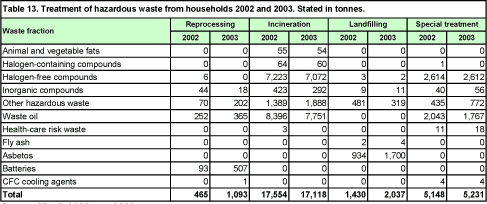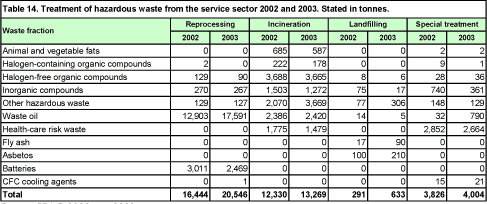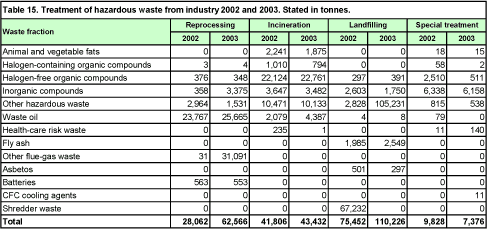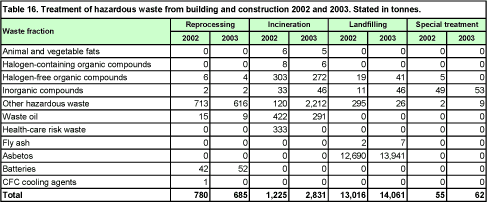|
Waste Statistics 2003 3 Hazardous wasteTable 12 shows treatment of hazardous waste in 2002 and 2003 by main group. The statement covers waste from both primary and secondary sources. A more detailed statement of hazardous waste, analysed by the ISAG fraction is in Annex 4. Table 12 has been changed somewhat from previous years to make it more comprehensible. This means that certain fractions are now only found in Annex 4. Waste from secondary sources, such as waste from incineration plants, is not included in total waste generation, cf. Table 1. This is because the waste would otherwise be counted twice in the statistics: the first time upon receipt at the primary treatment plant and the second time as a residue. However, it may be reasonable to include waste from both primary and secondary sources when estimating capacity needs for hazardous waste management. The table shows that hazardous waste from primary sources amounted to 328,349 tonnes in 2003. This is an increase of 80,848 tonnes from 2002. The increase is primarily attributable to the fractions: other hazardous waste, waste oil, and flue-gas waste. The waste category other hazardous waste shows an increase of 104,736 tonnes from 2002 to 2003. The major part of this increase originates from industry, which is seen in Table 15. Here we see an increase of 102,401 tonnes from 2002 to 2003 in the amount led to landfills. The significant increase is explained by the fact that shredder waste is landfilled free of tax. Waste which is landfilled free of tax cannot be categorised as shredder waste in the ISAG. This waste is therefore reported as other hazardous waste. From 2000 to 2001, the amount of hazardous waste increased by 57 per cent. However, by far the major part of this increase was due to changes in the method of reporting to the ISAG. From 2001 shredder waste must be reported to the ISAG separately. Previously this waste type was categorised as part of the non-hazardous fraction, “various non-combustible”. Shredder waste amounted to 67,232 tonnes in 2002. In 2003 it amounted to 0 tonnes [17] Hazardous waste from secondary sources amounted to 88,136 tonnes in 2003, which is 2,290 tonnes more than in 2002. Tables 13 to 16 show the amounts of waste generated by the four sectors: households, service, industry, and building and construction. 
Source: ISAG 2002 and 2003. 
Source: ISAG 2002 and 2003. 
Source: ISAG 2002 and 2003. 
Source: ISAG 2002 and 2003. The total amount of hazardous waste from industry is 223,600 tonnes, whereas the total amount from the service sector is around 38,000 tonnes, the total amount from households is around 25,000 tonnes, and the total amount from building and construction is around 18,000 tonnes. A comparison of the total amounts of hazardous waste from the four sectors shows that industry generated almost three times as much hazardous waste as the three remaining sectors put together. The building and construction sector, which generates least hazardous waste, has one primary source of hazardous waste, namely asbestos. Asbestos is also present in other sectors, however in significantly smaller quantities. Healthcare risk waste from the service sector, or more precisely from hospitals, is another hazardous waste fraction primarily originating from one sector. The three fractions waste oil, halogen-free organic compounds, and other hazardous waste occur in the largest amounts in industry, the service sector, and households. Inorganic compounds without halogens include e.g. solvents, dye/varnish/paint and tar, and rust-preventing oils. Inorganic compounds are found in significant amounts in both industry and the service sector. This fraction is found only in small amounts in both households and the building and construction sector. Footnotes [17] It should be noted that today shredder waste is reported as landfilled waste exempted from tax.
|